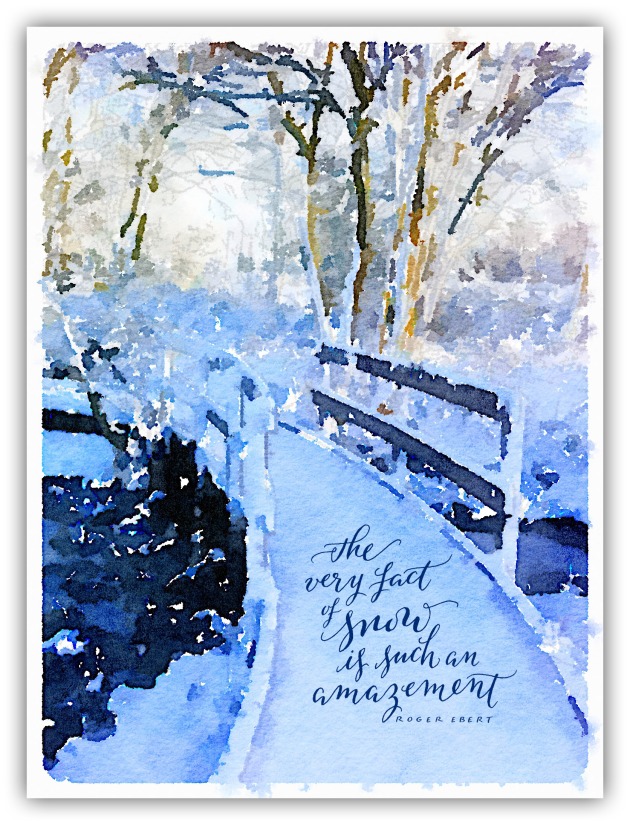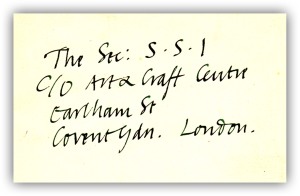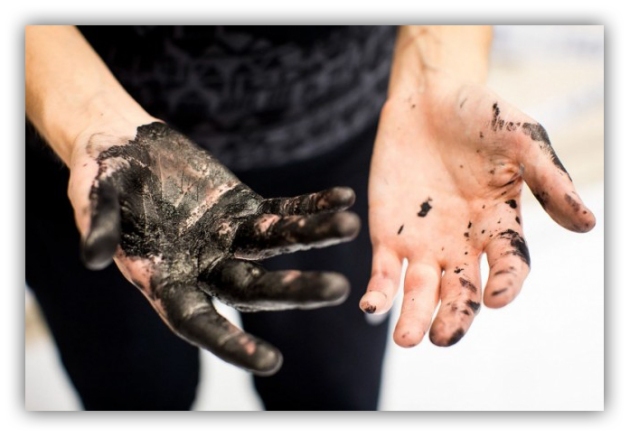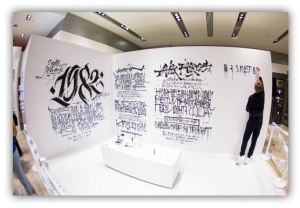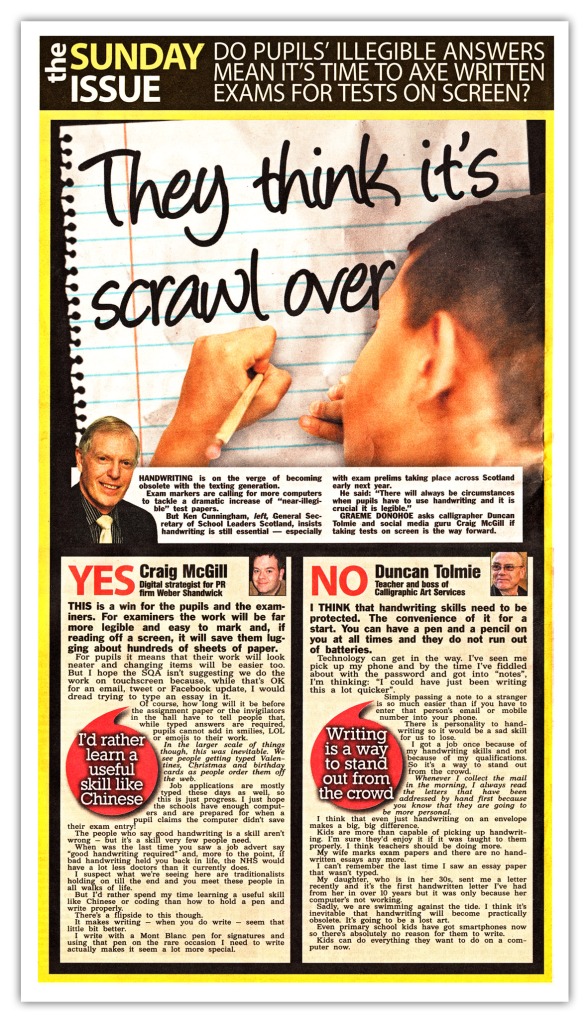A dead ringer for a calligrapher
June 16, 2022 1 Comment

My iPhone packed in a few days ago. One minute it was working, the next it wasn’t.
I tell a lie. Technically, it was working, because I could hear it ringing when someone tried to call me. And I could hear my various notifications arriving with a ding. But I couldn’t see anything, because the display refused to light up. The black screen of death, the Google doom-mongers called it. I didn’t like the sound of that.
I referred to dozens of YouTube videos, all offering the same few suggestions on how to fix the problem. Following their advice I pressed various buttons in various permutations. But although this technique worked successfully for the YouTubers and their many followers, my screen remained stubbornly black.
I hadn’t realised how dependent I was on the phone until I was denied access to everything that was on it. News headlines, train timetables, diary appointments, weather forecasts, football results, texts, photos, camera. I couldn’t even make an old-fashioned phone call. Everything that made my life worth living was suddenly inaccessible to me, and I felt empty inside. I was lost without my phone, and I wandered aimlessly around my home. My mood dipped, my temper was frayed at the edges. I had only been phoneless for a few hours, but already I was suffering from withdrawal symptoms.
Every ten minutes or so I pressed the phone’s home button, just in case it would miraculously perk up. I was in denial, acting out Einstein’s quote, insanity is doing the same thing over and over again, but expecting different results. You never know, I told myself. But, in my heart, I knew.
Early the next morning I took my iPhone to the Genius Bar of my local Apple Store for advice. Julie, the young assistant who was allocated my case, was amicable. She put me at ease with small talk.
“Are you going anywhere nice after this?” she asked me, while performing a diagnostic check on my phone.
“I’m actually going to a local university to write names on parchments,” I told her.
She looked at me blankly.
“I’m a calligrapher,” I explained.
“Oh… a calligrapher?” She regarded me with the same curiosity that she might normally reserve for a fossil. I think she was surprised that people in my line of work still existed.
“I tried calligraphy once,” she said, frowning. She raised her hand and performed a little air-writing in the space between us with her invisible pen. “It’s harder than it looks,” she admitted.
I didn’t bother revealing that, having taught calligraphy for three decades, I’d heard those five words repeated by almost every student I had ever taught. Sometimes by people I hadn’t taught. And each and every one of them wasn’t wrong.
“Do you have hundreds of names to write?” Julie asked.
“Actually, only a few,” I replied. “I’m inscribing the names of the recipients of honorary degrees. There aren’t many of those.”
“Do you mean famous people?” she asked.
“Some of them are famous. Not all.”
“What famous names have you written?”
This was becoming a proper little interrogation.
I attempted to remember famous names that I’d written, but my mind had gone totally blank.
I suddenly remembered someone. Someone relatively famous. Someone who would surely impress Julie. What were the chances of me remembering this particular person while sitting in an Apple Store? The only problem was… although I could see the person’s face clearly in my mind’s eye, I couldn’t remember their actual name. I wasn’t oblivious to the irony.
I threw it out there anyway.
“A few years ago I inscribed the name of the guy who took over from Steve Jobs,” I said.
“Tim Cook?” she proposed.
“That’s him,” I replied.
I was confident that Cook’s name would excite her. After all, what were the chances of Julie, an Apple technician, sitting here in an Apple Store checking the Apple iPhone of the guy who wrote the name of the Apple CEO on an honorary degree parchment? That was a lot of Apple in a very small space. A cartload of Apple. The odds of such an occurrence must be millions to one. Even I was astonished at the serendipity.
“That’s interesting,” Julie said, although I could tell that she didn’t really think it was. Her focus remained on the diagnostic screen.
“Ahhh… your phone’s display needs replaced,” she suddenly said, moving away. “Wait here and I’ll get a price for you.”
She returned a few minutes later. I doubted very much that, during her absence, she’d excitedly shared my Tim Cook revelation with her colleagues around the water cooler.
“Fitting a replacement screen will be £159.00,” she said. That includes a 90 day warranty.
After recovering from the shock of the quote, I was tempted to ask for a discount, since her CEO and I shared a (some might say slight) connection.
“I’ll think about it,” I said, reclaiming my useless phone.
By the time I reached the store’s exit I’d already thought about it. So I walked around the corner to a small phone repair store and requested a second opinion.
“It’s £70.00 to replace your display,” said the assistant, “with a twelve month warranty.”
It was less than half of Apple’s price, with the bonus of an extra nine months warranty.
“I’m happy with that, Tom,” I said, reading his name aloud from the tag around his neck.
Tom was friendly enough while he took my details, but he didn’t share Julie’s love of small talk. Unlike her, he didn’t ask me if I was going anywhere nice after this, so he never found out that he was fixing the phone of a calligrapher. Consequently, I never discovered if he’d tried calligraphy once and realised it was harder than it looked.
“Come back in an hour and your phone will be ready,” he said.
I did. And it was.
I picked up my phone and pressed the home button. The shiny new screen lit up and its brightness comforted me. As I pondered which app to open first, I felt a warm fuzzy feeling inside.
My phone was fully functional again. And so was I.
****************
I have no affiliation with the phone store that repaired my iPhone, and it’s not my intention to promote it. But, for anyone who’s interested, the company is called SimplyFixIt. I can honestly report that the technician there did an expert job of giving me my life back.
****************
For the technically-minded, I hand-lettered the Richard Branson quote in the artwork above using a black Tombow Fudenosuke brush pen with a hard tip. I scanned the black lettering into Photoshop, made the background transparent, and coloured the lettering white. I applied a subtle drop shadow to the lettering before layering it in front of a digitised watercolour wash. Finally, I saved the artwork as a JPG.




